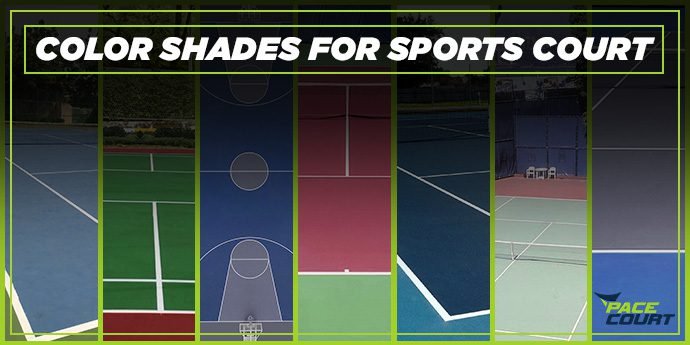Introduction
In tennis, minor variables can considerably affect how well someone plays. The color of every tennis court surface is one of the things that help a player to focus better because they need visibility and performance too. Pacecourt comprehends that acrylic surfaces play an important role by explaining how to choose appropriate colors for these courts. Choosing a suitable hue improves outlooks and makes it an exciting place where anybody would always love to be found. This article will focus on the relationship between tennis court colors and performance specifically outdoor ones using acrylic materials as an example. Some real-life scenarios have also been included as case studies demonstrating their realistic applications.
The Science of Color and Its Impact on Sports Performance
Colors may have a profound psychological effect on people, and in sports, they can have an immediate effect on an athlete's performance. People react differently to different hues, which might cause behavioral, energetic, and concentration changes in them. Consider the color blue, which is often associated with calm and peace, and the color red, which may evoke both vigor and anger. These impacts are evident on the tennis court because they influence how players react to different circumstances that arise during games.
Visibility and Focus: Why Color Matters
The visibility of a tennis court is crucial. Players must have a rapid vision of the ball, be able to keep an eye on their opponent and be able to make judgments swiftly. The color of the court has a big impact on this entire process. Best tennis court colors help players focus better by creating contrast between the ball and the court surface, which reduces visual stress and quickens reaction times.
Popular Tennis Court Colors and Their Influence on Gameplay

The best color choices for best tennis courts take into account factors other than aesthetics. The pros and downsides of selecting a certain color can vary depending on the location, lighting, and planned usage of the space.
Green Courts: The Classic Choice
There has always been a hint of green in the skins of the turf tennis courts. It serves as a reminder to the audience and players that these are grasslands. Green is a calming hue that helps players focus by creating a neutral environment. Additionally, it blends in with the environment in areas that are surrounded by trees and other flora.
However, in specific lighting conditions, the hue green might become problematic. Players may feel eye strain on extremely sunny days since the light surroundings make it difficult to see balls on the court.
Blue Courts: Increasing Contrast for Better Play
Over time, blue tennis courts are popular tennis court colors, especially during major competitions like the US Open and Australian Open. This is because they make it simple to distinguish between the court surface and the balls that are utilized (such as white or yellow), which are frequently moving quickly during rallies. This improves playing skills by allowing players to focus more intently on fast-channeling balls.
In addition to its therapeutic benefits, blue is thought to promote mental clarity and a calm state of mind that lowers stress. It guarantees that players remain effective throughout the game and do not falter even in difficult situations.
Red Courts: Energy and Intensity
Tennis courts are often associated with life and energy, especially in the vivid reds that are frequently seen at clay court competitions like the French Open. Red is said to quicken heart rate and release adrenaline, which helps players use aggressive gaming strategies. It is particularly useful in situations where players must use greater physical force since, in certain circumstances, strength may be more crucial to a match than skill.
However, red can be overly stimulating, which can lead to fatigue when combined unintentionally with qualities like brightness and adjacent hues.
Gray Courts: Modern and Neutral
Gray tennis courts are becoming more and more popular because of their sleek and contemporary appearance. In sunny climates, this neutral color can successfully reduce glare. Gray tennis courts are specifically designed to produce a noticeable contrast with white and yellow tennis balls, which enhances focus. Furthermore, gray is a color that goes well with a lot of different hues, so it often blends in with the surroundings of the court.
While they might not have the same psychological impact as bright hues like red or blue, gray courts can nevertheless provide a sense of harmony and balance for players.

Case studies
Case Study: Upgrading a Public Park Tennis Court
To improve the playing experience for the local community, the Delhi Public Park decided to upgrade its aging tennis courts. They opted for acrylic floors, understanding their advantages over the court's performance and resilience.
Project Overview:
- Location: Public Park in Delhi
- Project Scope: Resurfacing of two tennis courts
- Material Used: Acrylic flooring system
- Duration: 3 weeks
The Process: Initially, the project started with taking off the old broken surface. A concrete primer is then put on the prepared and leveled surface for strong adhesion. This was followed by multiple layers of acrylic coating, which yielded a smooth and long-lasting finish. Finally, markings of official dimensions were made on the courts so that they could agree with the required standards.
Results: The enhanced courts received high satisfaction rates from the locals. The players acknowledged the better grip and even ball bounce that significantly improved their play. Additionally, the bright color of the new surface made those courts more attractive, hence increasing their utilization.
Case Study: Enhancing a University’s Tennis Facilities
Tennis facilities at a university in Chennai need to be improved for its expanding tennis program. The management chose to invest in acrylic flooring for their outdoor courts to provide students and athletes a good playing surface.
Project Overview:
- Location: University Campus in Chennai
- Project Scope: Resurfacing of four tennis courts
- Material Used: Acrylic flooring system
- Duration: 5 weeks
Process: The courts that were already built in the community were thoroughly cleaned before the cracks were repaired. To ensure a good grip on the new acrylic surface, a primer was applied. Several coatings of acrylic paint were layered on its surface to make it smooth and long-lasting. To make sure that they meet official standards, these courts were marked out with precise dimensions.
Results: The University's athletic facilities were dominated by new courts. Recreational and competitive players alike praised the consistent playing surface and better traction. Also, vibrant colors on the courts improved campus aesthetics.
The Role of Acrylic Flooring in Outdoor Courts
Acrylic flooring is frequently used on outdoor tennis courts since it is now a popular choice. This is because it offers a reliable, wide-ranging service that is safe and resilient to different weather situations. The remarkable property of acrylic has capacity to hold colors and high-quality performance even after a long period.
Durability and Color Retention
Outdoor tennis courts are vulnerable to harsh weather conditions, including intense sun radiation, high humidity, and fluctuating temperatures. Consequently, the court's original colors are guaranteed to last even after extended game sessions thanks to the use of UV-resistant acrylic flooring. This is particularly important for tennis court colors, as fading over time may cause them to become less uniform or less apparent, which may impact visibility and ultimately the performance of the players throughout the match.
Customization Options with Acrylic
One of the main advantages of acrylic flooring is its wide color selection. Thus, acrylic floors can help consumers achieve their desired aesthetic, be it a traditional green court, a modern blue court, or an amazing purple court. Owners of tennis fields can create spaces that reflect their style, values, or even satellite areas thanks to this flexibility.
Ready to enhance your game? Discover the perfect tennis court colors for peak performance

Conclusion
Tennis court colors have practical purposes beyond aesthetic ones; they have a significant impact on players' focus and ability to play the game. The psychological reactions that different colors elicit—calm with blue, aggressiveness with red, or neutrality with gray, among others—help athletes stay focused, lessen eye strain, and perform better overall on the court. Manufacturing aesthetically pleasing and highly conducive acrylic surfaces for sports facilities puts Pacecourt at the forefront of this industry.
Owners of tennis courts can make well-informed judgments that benefit all users of the court by taking into account the psychological impacts of colors as well as the practical needs of the players. Acrylic flooring offers incredibly durable and adjustable options for tennis courts with color schemes that can be customized to fit any facility looking to improve player performance.
Frequently Asking Question
The budget, playing time, and player profile are all essential aspects for selecting a surface. During the consultation, our experts will discuss these aspects to help you in making a better decision.
Yes, we provide regular maintenance services to ensure the long duration and best performance of your tennis court. Our maintenance plans cover regular inspections, cleaning, and necessary repairs.
The budget, playing time, and player profile are all essential aspects for selecting a surface. During the consultation, our experts will discuss these aspects to help you in making a better decision.





